

Gold Hill is an unincorporated community in Storey County, Nevada, located just south and downhill of Virginia City.


Gold Hill is an unincorporated community in Storey County, Nevada, located just south and downhill of Virginia City.
Incorporated December 17, 1862, in order to prevent its annexation by its larger neighbor, the town at one point was home to at least 8,000 residents. Prosperity was sustained for a period of 20 years between 1868 and 1888 by mining the Comstock Lode, a major deposit of gold and silver ore. Mines such as the Yellow Jacket, Crown Point, and Belcher brought in over $10 million each in dividends. Historical remnants of the town can still be seen, including the Gold Hill Hotel, promoted as Nevada's oldest hotel, in existence since 1861; the former Bank of California building; the restored Virginia & Truckee Railroad depot; the Depression-Era Crown Point Mill; and remains of several of the mines and residences in various states of restoration and repair.
Although in the shadow of neighboring Virginia City, Gold Hill, nonetheless enjoyed a lively entertainment industry. The Gold Hill Daily News was established in 1863, and Gold Hill enjoyed a theater by 1862. The demographic mirrored Virginia City where one third of the population was engaged in mining and the Irish immigrant dominated numerically. [1] Newspaperman Alfred Doten is associated with the town. His numerous journals, available at the University of Nevada, Reno Special Collections, provide a rich and detailed history of his experiences in the American West during the nineteenth century. [2] One of the main settlements for the Cornish on the Comstock lode was in Gold Hill. [3]
A later mining complex in the area operated from 1927 until 1942, when mining operations were shut down by War Production Board order L-208, shutting down all nonessential gold mines in the United States. Just under a hundred million dollars' worth of ore was extracted after 1930. Active mining has returned to lower Gold Hill, with the start of production at Comstock Mining's Lucerne, Hartford and Billy The Kid mines. The Gold Hill post office remained in operation until 1943.
In 1976, Bob Gray, a former Marine Corps photographer in World War II and admirer of the Virginia & Truckee Railroad since he was a teenager, bought a section of the abandoned railway line between Virginia City and a point about two miles south. He laid track on that right of way and began operating a steam-powered tourist railroad. [4] The track was extended to Gold Hill in 1992, and in 1994 the Gold Hill Historical Society was established to preserve the Gold Hill depot, one of the few wooden structures in the region that survived the 1875 fire in Virginia City. After ten years of applying for grants, lobbying, and collecting steel rail donations by the Gold Hill Historical Society, the mayor of Carson City approved the letting out to bid of a contract to reconstruct the railroad between Gold Hill and the Carson River, fifteen miles away. [5] Today, Gold Hill is a stop on this tourist railroad, which operates historic steam trains attracting thousands of tourists each year.
Today, Gold Hill exists as a shell of its former self; its population in 2005 was 191. [6] It is part of the Reno – Sparks Metropolitan Statistical Area.
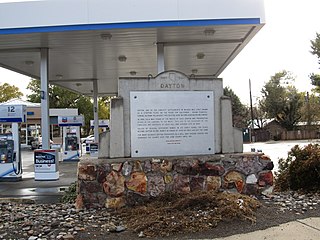
Dayton is an unincorporated community and census-designated place (CDP) in Lyon County, Nevada, United States. The population was 15,153 at the 2020 census. Dayton is the second oldest Nevada settlement. It is home to the oldest hotel in Nevada.

Virginia City is a census-designated place (CDP) that is the county seat of Storey County, Nevada, and the largest community in the county. The city is a part of the Reno–Sparks Metropolitan Statistical Area.

The Carson River is a northwestern Nevada river that empties into the Carson Sink, an endorheic basin. The main stem of the river is 131 miles (211 km) long although the addition of the East Fork makes the total length 205 miles (330 km), traversing five counties: Alpine County in California and Douglas, Storey, Lyon, and Churchill Counties in Nevada, as well as the Consolidated Municipality of Carson City, Nevada. The river is named for Kit Carson, who guided John C. Frémont's expedition westward up the Carson Valley and across Carson Pass in winter, 1844. The river made the National Priorities List (NPL) on October 30, 1990 as the Carson River Mercury Superfund site (CRMS) due to investigations that showed trace amounts of mercury in the wildlife and watershed sediments.

The Comstock Lode is a lode of silver ore located under the eastern slope of Mount Davidson, a peak in the Virginia Range in Virginia City, Nevada, which was the first major discovery of silver ore in the United States and named after American miner Henry Comstock.
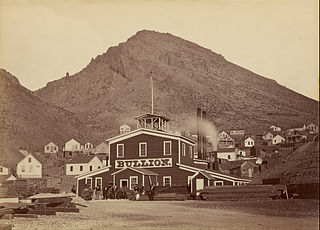
The Virginia Range is a mountain range of western Nevada, primarily within Storey County, and extending east into Lyon County. The range is named after James Finney, "Old Virginny", an early discoverer of gold associated with the Comstock Lode.

The Virginia and Truckee Railroad is a privately owned heritage railroad, headquartered in Virginia City, Nevada. Its private and publicly owned route is 14 miles (23 km) long. When first constructed in the 19th century, it was a commercial freight railroad which was originally built to serve the Comstock Lode mining communities of northwestern Nevada.

Carson City is a 1952 American Western film directed by Andre de Toth and starring Randolph Scott, Lucille Norman, and Raymond Massey.

Silver City is a Census Designated Place and small residential community in Lyon County, Nevada, USA, near the Lyon/Carson border. The population as of the 2020 census was 155.

State Route 342 is a short state highway in Nevada, United States. It is a loop route of State Route 341, running north through the communities of Silver City and Gold Hill before returning to State Route 341 near Virginia City. This highway is a historic route, dating back to the Comstock Lode of the 1860s. The highway loosely parallels, and crosses, the route of the Virginia and Truckee Railroad. Prior to renumbering in the 1970s this route was known as State Route 80.
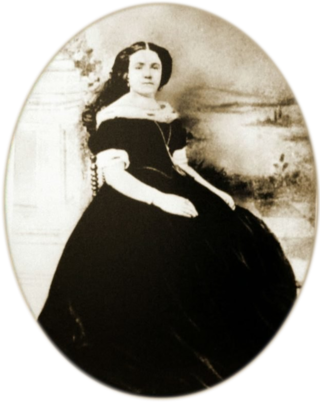
Alison "Eilley" Oram Bowers was a Scottish American woman who was, in her time, one of the richest women in the United States, and owner of the Bowers Mansion, one of the largest houses in the western United States. A farmer's daughter, Bowers married as a teenager, and her husband converted to Mormonism before the couple immigrated to the United States. After briefly living in Nauvoo, Illinois, she became an early Nevada pioneer, farmer and miner, and was made a millionaire by the Comstock Lode mining boom. Married and divorced two times, she married a third time and became a mother of three children but outlived them all.
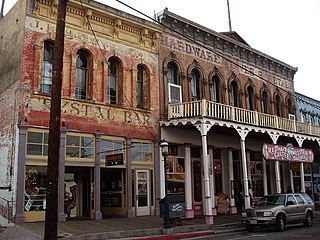
Virginia City Historic District is a National Historic Landmark District encompassing the former mining villages of Virginia City and Gold Hill, both in Storey County, as well as Dayton and Silver City, both to the south in adjacent Lyon County, Nevada, United States. Declared a National Historic Landmark in 1961, the district is one of only six in the state of Nevada.
Silver mining in Nevada, a state of the United States, began in 1858 with the discovery of the Comstock Lode, the first major silver-mining district in the United States. Nevada calls itself the "Silver State." Nevada is the nation's second-largest producer of silver, after Alaska. In 2014 Nevada produced 10.93 million troy ounces of silver, of which 6.74 million ounces were as a byproduct of the mining of gold. The largest byproducers were the Hycroft Mine, the Phoenix Mine, the Midas Mine and Round Mountain.
Poeville, also known as Peavine until 1863, is the site of a historical mining town, established in 1864. John Poe, a professional promoter from Michigan allegedly related to Edgar Allan Poe, discovered rich gold and silver veins in 1862 on the slopes of Peavine Mountain. After the discovery of ore, Poe announced that the veins comprised the next Comstock Lode; he presented extracted ore at the state fair of 1864 as rich in content. As a result, the former mining camp, called Poe City (Poeville) or Podunk (Poedunk), grew to 200 people by 1864. Ore production in the mining district and population peaked around 1873-1874 with several hundred people living in town, supported by three hotels and a post office. The post office, named "Poeville", operated between September 1, 1874, and March 24, 1878. As of 2010 the population of the community is 0.

Julia Bulette, was an English-born American prostitute in Virginia City, Nevada, a boomtown serving the Comstock Lode silver mine. She was murdered in 1867 and a French drifter named John Millain was quickly convicted and hanged for the crime. Subsequent legends surrounding Julia's life and status as a sex worker and madam have grown over time and become a part of Virginia City folklore.

Eagle Valley is the area encompassing Carson City, Nevada. The valley was first settled during the California Gold Rush of 1849. The discovery of Nevada's Comstock Lode in 1859 established the economic importance of the area, which would become the site of the Nevada State Capitol.

William Matthew Ormsby was an early settler of Nevada who was instrumental in the establishment of Carson City and the Nevada Territory. Major Ormsby was killed leading a Militia force against Paiute Indians in what was called the Pyramid Lake War.
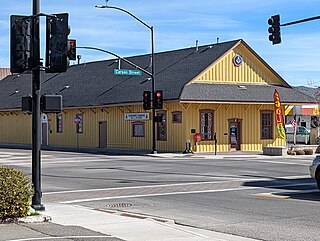
The Virginia & Truckee (V&T) Railroad Depot of Carson City, Nevada, is a historic railroad station that is listed on the U.S. National Register of Historic Places (NRHP). It is significant for its association with the economically important role of the V&T railroad historically in Carson City following discovery of the Comstock Lode mine in 1859. To a lesser degree, according to its NRHP nomination, the depot building is also significant architecturally "as a well-preserved example of a wood-frame passenger depot procured from a railroad company pattern book within the V&T's former sphere of operation."

Como is a ghost town in Lyon County, Nevada, in the United States.

Steamboat Creek drains Washoe Lake, flowing north to northeast through Truckee Meadows and finally intersecting the Truckee River, east of Reno, Nevada. Historical documents indicate that in the early 1860s there were at least six mills reducing Comstock ore in Washoe Valley and during these earliest days of the Comstock mining.
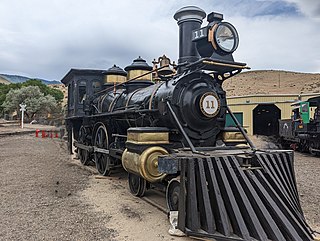
Virginia and Truckee Railroad No. 11, the "Reno", is a surviving 4-4-0, "American"-type steam locomotive. It is one of three largely identical 4-4-0 locomotives built by Baldwin for the railroad, the others being the Genoa and the Inyo, and one of four V&T 4-4-0's preserved. The engine is one of Hollywood's most prodigious Flanged Star, starring in over 120 films, commercials, and television episodes starting in 1937. Today, the 2nd oldest surviving example of the Baldwin 4-4-0 type is undergoing restoration at her original home in Virginia City, Nevada.
39°17′26″N119°39′27″W / 39.29056°N 119.65750°W